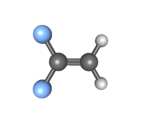Vinylidene fluoride
|
|
|||
| Names | |||
|---|---|---|---|
|
IUPAC name
1,1-Difluoroethene
|
|||
| Other names
Difluoro-1,1-ethylene; R-1132a; Halocarbon 1132 A; Freon 1132A; Vinylidene difluoride; Vinylidene fluoride
|
|||
| Identifiers | |||
|
3D model (JSmol)
|
|||
| Abbreviations | VDF | ||
| ChemSpider | |||
| ECHA InfoCard | 100.000.789 | ||
|
|||
|
|||
| Properties | |||
| C2H2F2 | |||
| Molar mass | 64.03 g·mol−1 | ||
| Appearance | Colorless gas | ||
| Odor | Slightly ethereal | ||
| Density | 2.89 kg/m3 (vapor, 0 °C) 1.122 g/mL (liquid, -84 °C) |
||
| Melting point | −144 °C (−227 °F; 129 K) | ||
| Boiling point | −84 °C (−119 °F; 189 K) | ||
| 0.254 g/L | |||
| Vapor pressure | 35.2 atm (20°C) | ||
| Hazards | |||
| Main hazards | Flammable | ||
| 380 °C (716 °F; 653 K) | |||
| Explosive limits | 5.5%-21.3% | ||
| US health exposure limits (NIOSH): | |||
|
PEL (Permissible)
|
none | ||
|
REL (Recommended)
|
TWA 1 ppm C 5 ppm | ||
|
IDLH (Immediate danger)
|
N.D. | ||
|
Except where otherwise noted, data are given for materials in their standard state (at 25 °C [77 °F], 100 kPa).
|
|||
| Infobox references | |||
1,1-Difluoroethylene also known as vinylidene fluoride, is a hydrofluoroolefin. It is a flammable gas. Global production in 1999 was approximately 33,000 metric tons. It is primarily used in the production of fluoropolymers such as polyvinylidene fluoride.
1,1-Difluoroethylene can be prepared by elimination reaction from a 1,1,1-trihaloethane compound, for example, loss of hydrogen chloride from 1-chloro-1,1-difluoroethane:.
or loss of hydrogen fluoride from 1,1,1-trifluoroethane:
...
Wikipedia


